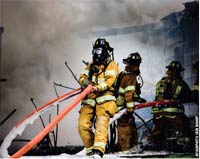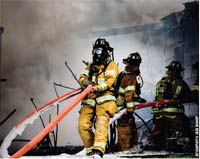
Fire Safety for Maintenance Operations
Stick to your policy -- two drills per year, one per month, whatever frequency your policy and type of operation require.
 Smoke was billowing from the third-floor fire escape stairway of a hospital at 5 p.m. on a Friday. It is a scene I will always remember: Someone pulled a fire alarm, and soon the professional firefighters were dragging hoses as employees responded with hand-held fire extinguishers. Patients were moved to other floors, quickly and expertly. Years of training had come together in a fast facility response.
Smoke was billowing from the third-floor fire escape stairway of a hospital at 5 p.m. on a Friday. It is a scene I will always remember: Someone pulled a fire alarm, and soon the professional firefighters were dragging hoses as employees responded with hand-held fire extinguishers. Patients were moved to other floors, quickly and expertly. Years of training had come together in a fast facility response.
Massive effort and manpower resources were instantly put into use for facility fire protection to protect lives that day. What was the culprit? Two clever employees had been using a big charcoal grill on an exit stairway, and their fire went out of control. The only positive thing I could think to do was advise upper management that all of our planning and drills really worked in a crisis.Unhappy as I was that the fire was caused by employee non-compliance, at least it showed areas where the practice and safety message was getting through, and some areas we needed to improve. We know in safety there always are areas that need improvement!
All of us have seen what happens when fire safety works well: Employees and others escape unharmed. Physical destruction is lessened or avoided completely. Work life resumes quickly and moves forward. Unfortunately, we also have seen what happens when our efforts fail: Senseless death and destruction. Employees who do not evacuate are injured or die; fires grow out of control and destroy entire businesses that cannot recover. Fire safety efforts have to work when needed to save lives, and there is no time to read the manual or converse or think about it.
The planning stages are done. Our response has to be automatic and fast. How does your facility’s fire safety program stack up? In a real emergency, would your employees know how to react, and will they respond quickly and correctly? Now is the time to make your physical location fire-safe and to train the employee in fire drill procedures.
Safety Committees Aid Maintenance Pros
As safety professionals,we often must become the “bad guy,” from the planning stage to day-to-day efforts to ensure safety and fire-safe work places are practiced. Whether the site is a hospital with critical care, a highrise office building with thousands of employees from multiple companies, food distribution centers, prisons with dangerous inmates incarcerated, or the smallest family-owned company, fire safety is one of the most important and frequently most thankless roles.
As Safety, we remove non-fire-resistant decorations (like those hundreds of paper snowflakes hanging from the ceiling at Christmas), clear blocked exits, direct the removal of personal appliances that are scary, and endlessly negotiate to stop acts that go beyond hazardous and border on stupid. And we do this with some degree of professionalism and decorum. It’s not easy . . . emphasizing the basics of fire safety is one of our toughest jobs.
I constantly remind maintenance staff to alert me to the unusual, the unsafe, and the just plain weird things they see daily that would impede fire safety efforts and our facility’s ability to evacuate an area or building in an emergency.Cast a critical eye on the annual maintenance activities that go hand in hand with fire safety, such as fire extinguisher annual inspections, monthly visual inspections, fleet vehicles’ fire extinguishers, your facility’s physical fire apparatus and testing, exit lighting, paths, and potential obstructions. This is also a great time to include your safety committee— many sets of eyes can alert you of problem areas as they walk through with a different perspective than those who conduct maintenance operations.Your maintenance staffers are usually appreciative of help and welcome the questions.
Fire safety is assisted greatly by planning ahead and lots of practice for employees. They may be bored to tears with all of the information and drills, but later they’ll thank you if a real emergency happens and they know exactly what to do and how to escape. We all know safety is usually an afterthought for employees, and our fire safety efforts often draw more employee wrath than other areas. Drills take time and effort to respond, and our policies often say “no”to changes, additions, or materials/appliances they want in their personal work spaces.We have to be constantly vigilant. Saying “no” may save a life!
Key Points to Address
Fire safety reminders. This season of the year is a very good time for your annual fire safety refresher for all employees. (Remember to document this, too.) Explain why fire drills are held, the use of alarms, exit paths for each building, collection points for everyone outside, and what will happen if they do not participate in drills. Your format can be the town hall meeting, supervisor meetings, paycheck stuffers, the company’s Web site/intranet, or posters. Just get the word out and make sure everyone has some method to ask questions.
Remind new employee orientation staff of what is needed for all new folks.Are visitors or disabled staffers routinely in the building? Remind all employees how to respond and assist.
Drills. Explain to everyone why exit drills are so important, and use real examples such as the World Trade Center bombing and terrorist attacks. Reality may be as simple as the burnt microwave with popcorn left unattended, causing billowing smoke.
The time to practice is long before a real need. Stick to your policy — two drills per year, one per month, whatever frequency your policy and type of operation require.Make sure your employees know how to completely evacuate the building and where to gather outside away from the structure. These are important information that is often overlooked as staffers retire and new hires get lost in the shuffle.
Decorations. As the main holidays begin to wane, make sure all exit lights; fire doors, etc. are free of paper and decorative items that may obscure quick exiting. Explain to employees the need to limit decorations, plants that take over hallways, or items that block quick exit during a fire.
Personal rugs can pose tripping hazards, and that table with the coffee pot or bowl of candy may impede exit, too. This is a constant battle. These changes take only a few minutes to become a hazard, and after just a day or so, they become normal to the staffers in the area. This is one reason why an outsider such as Safety must walk through regularly, viewing the areas from a safety standpoint—not a decorator’s eye.
Personal appliances. If your company does not have a policy for personal electrical appliances, it is time to implement one! Personal space heaters, portable air conditioners, fans, pizza cookers, refrigerators, huge stereo systems, therapy fountains, and fish tanks all can pose fire safety issues (some more than others).Develop a reasonable expectation of what is needed in the workplace and stick to it. Make sure upper management agrees with your efforts so that you have the muscle to enforce removal!
Furniture. Make certain the furniture is what you approved and that employees are not allowed to bring in personal items without your approval. All finishes are not fire resistant; other, newly acquired items may suddenly appear in a hallway where they are not allowed. Employees regularly change their office work areas and may alter the path to exit or block it with file cabinets and other items in what they intend as a change of decorations or better layout. Even cubicle walls may move in the middle of the night for one more foot of work space.
Clear paths to exits. Ensure everyone knows what has to stay clear and why. Employees constantly want to “improve” areas that appear barren with all sorts of unapproved items. Make it clear and be consistent what is allowed and not allowed.
Basic hazards such as cords running through walkways, personal rugs in doorways, extra guest chairs, etc. The list of hazards is as endless as your employees’ enthusiasm for change.
Fighting Complacency
People by nature get complacent when nothing bad, such as a fire, happens.As safety professionals, we are balancing the hysterical label by quietly, consistently, constantly reinforcing our facilities’ fire safety programs one item at a time.We like quiet, but we have to require compliance with our policies, our drills, and basic, commonsense workplace safety.
Be positive in your attitude; be relentless and compassionate in your planning, but be unyielding in your enforcement efforts. The payoff is saved lives and property damage, even though you will never know how the little changes avert such tragedy.
This article originally appeared in the January 2009 issue of Occupational Health & Safety.